



 Key to Species Articles
About
Key to Species Articles
About

Evolution illustrated by ForaminiferaForaminifera may perfectly illustrate evolution at work. As single celled organisms with a short life-cycle foraminifera and the composition of a specific foraminiferal fauna adopt rapidly to even small environmental changes. The great abundance of foraminifera in marine space and time in the long fossil record may be used to perfectly illustrate evolution. |
LAGENIDAE Reuss,1862 from Kobrow, Germany, Oligocene |
Introduction |
Globigerinids from Antarctica specimens picked and placed by Karl Otto Bock |
||||
| A most exciting part in foraminiferal study is when you come home with your samples and take a glance at the first 5-10g of the collected material. Outside you may only know from your field binocular that there is something in it. But at home with a proper microscope you may find hundreds of tests in 5g of rich material. After some hours tens of Globigerinids are separated as seen to the right. Each test is different to the others. You begin to think, I studied only 5g of this recent material, million of tons are lying on the seaflor now, all tests are different from eachother, most from one generation of the last 3-5 months, big, small, some aberrant, Globigerinids exist since 60.000.000 years or was it more ? - may this be explained by evolution??? Flip the coin: May evolution be explained with foraminifera ? Why not - they are so abundant and found in the fossil record since at least the Cambrian. I will give it a try in 2010. Michael Hesemann
|
 |
What Evolution is
The Theory The theory of evolution wants to explain how we - meaning all living organisms - came to be in all our complexity and variation. Biological evolution is simply seen as a change in the frequency of genes through time. Charles Darwin (1809-1882) published 1859 his seminal work On the Origin of Species. Genes were not yet known but Darwin referred to the directly linked heritable characters, which are passed from parents to offspring. Mutations The passing process of genes is remarkably accurate but not 100% perfect, mistakes happen which are called mutations. These mutations cause differences between the single organisms, which result sometimes in differences in their fitness to reproduce. Natural selection In a group of organisms the environmental conditions will favour some individuals while others will not reproduce as well. If heritable characters are the cause a shift in their frequency within a population will occur. This process is called natural selection. Time Gene frequencies can remain constant for long periods of time and changes happen gradually. The huge variety and complexity of todays live on Earth needed a long time period to evolve. The fossil record shows indeed a very long time period, illustrated by findings of seashell fossils on high mountain tops. The earliest fossils - single celled organisms - are dated back to more than 3.500.000.000 years. Evolvement of complex liveforms The rising complexitiy of live needed long periods of only small changes in environmentals conditions to evolve. Abrupt changes caused in special the extinction of complex species, best illustrated by the extinction of the dinosaurs. Simple forms of live such as the foraminifera Reophax living in the sediment were almost not affected at all. |
recent Globigerinoides Pacific Coast of Mexico 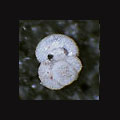 |
Natural selection leads to specific foraminiferal faunas in specific environments Open Sea offers little nutrition, which makes survival very difficult though competition is low and predators are rare. Planktonic foraminifers such as Globigerinoides use symbiont algae, who deliver energy through photosynthesis. In return Globigerinoides gives shelter for the little algae in its chambers, which need to be transparent, so that the sunlight may pass. Its globose construction allows sinking and up and downward drift in the watercolumn, probably needed to follow food, avoid predators and UV-radiation. |
about 2 Ma old fossil Globigerina Torrente Stirone, Italy  |
||
recent Planorbulina Crete, Mediterranean Sea 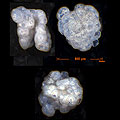 |
An elevated life position is advantageous as many competitors and predators live directly on the sea floor. Some foraminiferal tests show imprints of the substrate they were attached to, such as stems or leafs of algae and plants. Such a life-style depends on the possibility to attach to something, as found in seaweed meadows of shallow waters. A very small percentage of oceans-space offers such a habitat, which is vulnerable too. |
recent Cibicides Barna, Ireland, Atlantic Ocean  |
||
about 30 Ma old fossil Lenticulina Kobrow, Germany 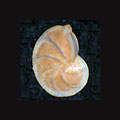 |
Planispirally enrolled, round tests as build by Lenticulinas are advantagous to move through the upper and moderately condensed parts of the sediment. Recent specimens of planispiral genus Elphidium from around the world are observed to live on and in the sediment:   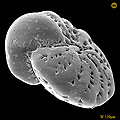 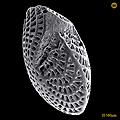 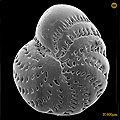 |
about 185 Ma old fossil Lenticulina Buttenheim, Germany 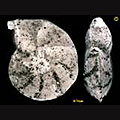 |
||
recent Reophax from the bottom of the Greenland Sea, Arctic  |
The advantage of simple life forms, when severe changes of environmental conditions occur, is shown by the foraminiferal genus Reophax. It builds a simple row of chambers from pieces of sediment cemented together. A recent Reophax looks similar to a 30.000.000 years old Reophax from the Oligocene. There may have been no advantage to change its construction plan. The genus is in the fossil record since 460.000.000 years. After the Cretaceous/Tertiary extinction event when the dinosaurs went extinct, Reophax took advantage of the extinction of higher developed foraminifera. It peaked in worldwide abundance taking over the free living space. |
about 30 Ma old fossil Reophax from Kobrow, Germany  |
Mutation and Variation |
||||
under construction |
Natural selection |
||||
under construction |